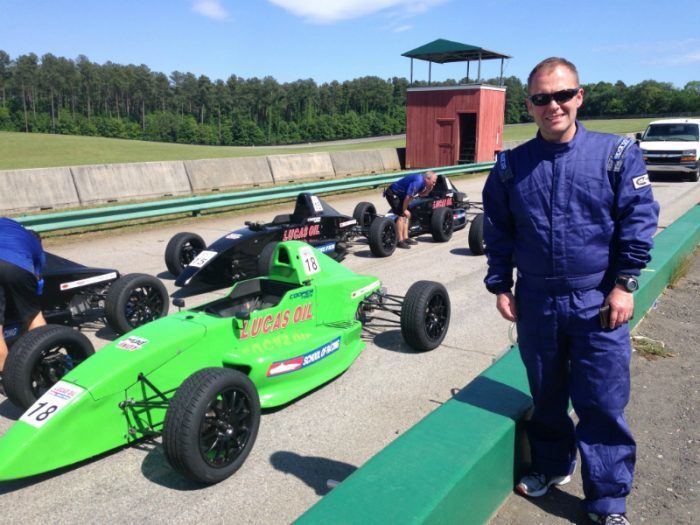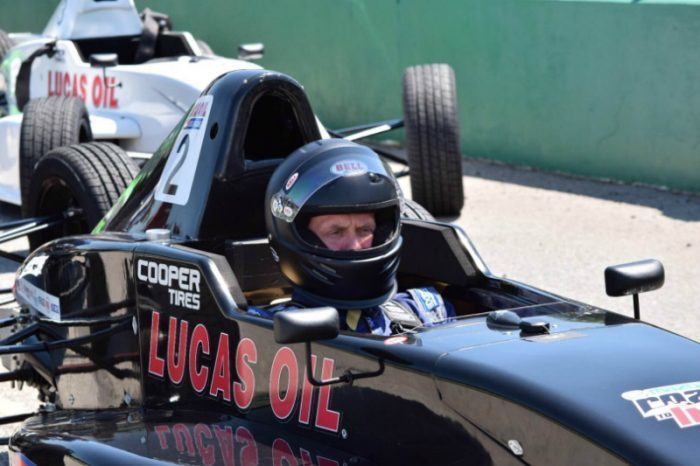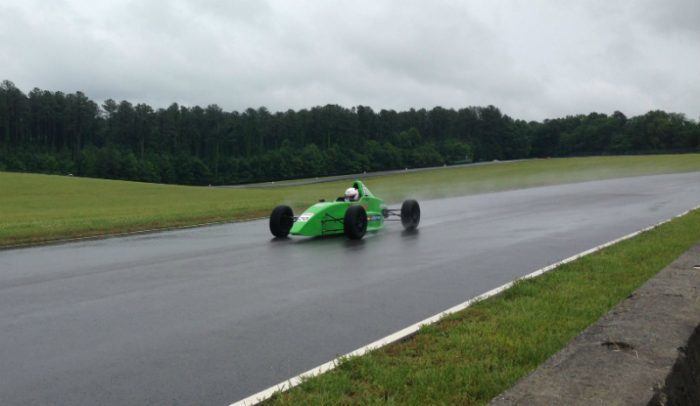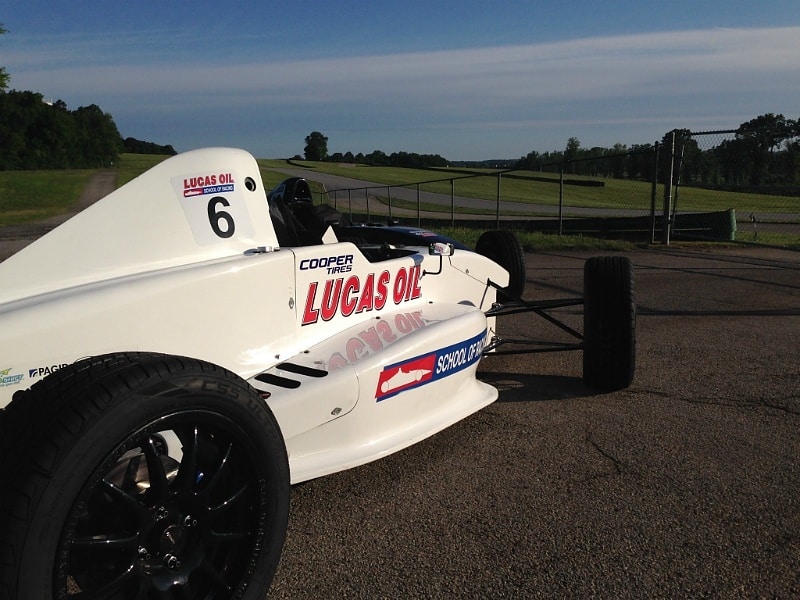Anyone who loves cars has likely had a Walter Mitty moment, dreaming of piloting a race car down a winding track. Most of us would likely admit we’ve fantasized about carving the corners in Monaco, or going wheel-to-wheel with Patrick Dempsey in a privateer GT3 on the Mulsanne Straight at Le Mans.
Brake, steering wheel, accelerator. I mean how hard could it be? Just make sure the leggy models on the winner’s podium are under 5’4” so they won’t tower over me when I’m holding the trophy.
Eager to bring my Walter Mitty dreams to life (and perhaps be discovered as an untapped racing genius), I happily accepted an invitation to a Lucas Oil School of Racing session at Virginia International Raceway.
Lesson #1
Don’t wreck the cars.
The Lucas Oil School of Racing is a relative newcomer to the racing school scene. Founded in December 2015 by Florida businessman and racing team owner Neil Enerson, they seek to bring a breath of fresh air into the largely staid racing school industry.
Marketing Director James Altemus believes it’s been on the decline for many years.
“There are fewer players, they are more regional, and the cars they use are less and less relevant to cars being raced professionally and in various development series,” Altemus said. “We saw the opportunity to come into the market with a modern formula car, complete with modern elements like paddle shifters, video and data acquisition, and greater tuneability thanks to electronics.”
My training starts in the classroom with an early morning briefing and waiver signing. The class is led by veteran racer Randy Buck, the school’s gregarious, mustachioed chief instructor, and one of several highly seasoned trainers on staff.
Here I confront race car driving lesson number one: don’t wreck the cars. We may all have track day fantasies, but Walter Mitty never had to face a $3000 damage deductible if he planted the car into a barrier.

Lesson #2
Maybe racing careers aren’t for poor journalists.
The class was surprisingly small, just six of us, but I find I’m surrounded by drivers with significantly more seat time than me. Two of the other students are just teens, but hardly rubes out to learn how to parallel park: both are skilled karting racers and former national champs.
I find only one fellow student close to my rookie status, Patrick, but he’s at least attended one other driving school. Reality sets in for me early.
The Lucas Oil School uses a small, open wheeled Ray Formula Car GR11, an F3 homologation car built in Britain. The Ray is small and sleek, and reminds me of what the adolescent child of two full-fledged F1 cars would look like if they mated.
Customized for the school, the Ray is equipped with a 2-liter four cylinder engine and paddle shifters with rev matching. One great perk is how the cars include a data acquisition and video system to provide that oh-so-important high-tech feedback.
Our first day starts with braking, stuck throttle, and cornering exercises. The Ray is high-tech but has no anti-lock brakes. I find my lifetime of conservative braking has not prepared me to explore the limits of wheel lock.

Lesson #3
Hit the brakes hard while racing. I mean really, really hard.
It’s during some of the braking and cornering exercises that I get to experience my first spinouts on the track. It’s shocking when it does finally occur, like a carnival ride suddenly breaking free and depositing you in the grass. Most of us do eventually wipe out at some point, including the semi-pro teens.
While feeling a bit chagrined the first time it happened, my fellow student Patrick offers a refreshing perspective that cheers me up.
“If you spin, it means you’ve got the balls to really push it.”
Lesson #4
Every person wipes out sometimes. Or maybe Patrick was just being nice?
We finish day one with some open lapping that allows us to work on putting together all the pieces we’ve learned. Trying to master the proper line and braking in the turns is a challenge, but I quickly come to find the long straightaway is the most fun. It comes right after a turn known as “Oak Tree,” though the eponymous tree is no longer standing.
I usually mangle the sweeping right hand turn at Oak Tree, but love running out the small Ray, hitting max speed, and bumping up against the rev limiter. I try desperately not to lift off the accelerator or brake too soon into the approaching hairpin.
And then I do both.
Nonetheless the sense of speed is intoxicating. The open cockpit and wind buffeting provide a visceral experience our hermetically sealed, everyday cars just can’t match.
We were blessed with gorgeous weather the first day, but day two is awful. It’s overcast and pouring rain. The cars have ordinary, street-legal Cooper performance tires, well suited to a wet track, but the rain offers a whole new level of white-knuckle excitement.

Lesson #5
Racing in the rain scares the you-know-what out of me.
I ultimately take a short break from the driving, sitting out one of our rainy lap sessions to grab pictures. After lunch my confidence returns, as does the clear weather. We’re able to complete our syllabus, including the rolling practice starts to satisfy racing licensing standards.
After two long days, I’m tired but exhilarated. And all too aware of my limitations. Of course, a mere few hours on the track for a newbie like me is just a bit of introductory fun. As Randy repeatedly emphasized, it’s hard to beat experience.
“Seat time is key. Most people wildly underestimate how much value there is in [just] driving. Everyone needs time to be trained,” he said.
Lesson #6
Good race car drivers might be born, but they also require a lot of track time. Maybe there’s hope for me yet?
The Lucas Oil School of Racing proved both educational and eye-opening. I’m not the savant I hoped, but my two days on the track was stupid fun. I may not be ready for Le Mans, but I certainly have a new appreciation for what seasoned pros make look so easy on TV.
The Lucas Oil School of Racing offers training classes around the country and throughout the year. The basic training session I took started around $2,000 per seat, with all Walter Mitty types welcome.
*Jonathan Orr is a writer, car aficionado, PR pro, Afghanistan veteran, and proud father. He considers his beloved Porsche 911 a member of the family. Follow him on Twitter: @jonathanjorr


